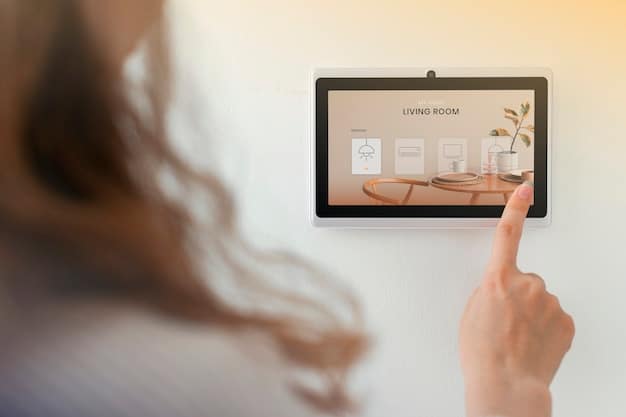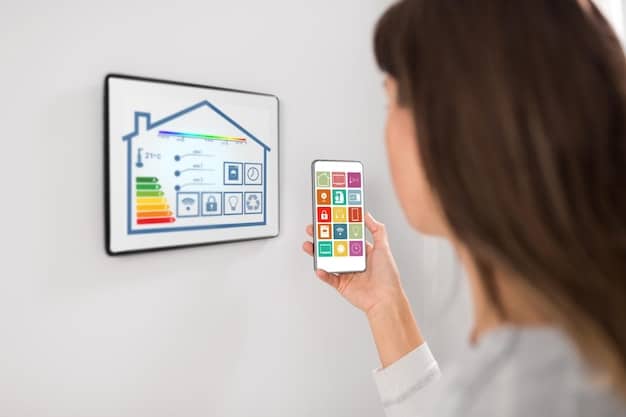Smart Thermostat Buying Guide: Save on Energy Bills in 2025

Navigating the smart thermostat market in 2025 requires understanding key features, compatibility, and energy-saving potential; this guide helps US consumers make informed decisions and potentially save up to 15% on energy bills.
Ready to upgrade your home and save money? Our Smart Thermostat Buying Guide: Save Up to 15% on Energy Bills in 2025 helps you choose the best smart thermostat to optimize energy consumption and reduce costs.
Understanding the Smart Thermostat Revolution
Smart thermostats are revolutionizing the way we manage home climate control. These devices offer a blend of convenience, energy efficiency, and cost savings, making them an increasingly popular choice for homeowners. They’re no longer just about setting a temperature; they’re about creating a smarter, more responsive home environment.
What Makes a Thermostat “Smart”?
Smart thermostats go beyond traditional thermostats by incorporating advanced technologies. They connect to your home’s Wi-Fi network, enabling remote control via smartphones or tablets. Many models learn your heating and cooling patterns, automatically adjusting to your schedule.
- Remote Control: Adjust your home’s temperature from anywhere with an internet connection.
- Learning Capabilities: The thermostat adapts to your preferences and habits over time.
- Energy Monitoring: Track your energy usage to identify areas for potential savings.
These features not only provide convenience but also contribute significantly to energy conservation.
The Growing Popularity of Smart Thermostats in the US
The US market for smart thermostats is experiencing substantial growth. Consumers are drawn to the promise of reduced energy bills and the convenience of remote control. Additionally, government incentives and rebates are making smart thermostats more accessible to a wider range of homeowners. As awareness of environmental issues increases, smart thermostats are increasingly seen as a way to reduce one’s carbon footprint.
Smart thermostats are not just a fad, they’re a practical tool for managing energy consumption and reducing environmental impact.
Key Features to Consider When Buying a Smart Thermostat

Choosing the right smart thermostat involves considering several key features. These features directly impact the device’s functionality, ease of use, and potential energy savings. Prioritizing your needs and preferences will help you narrow down the options.
Compatibility with Your HVAC System
Before purchasing a smart thermostat, ensure it’s compatible with your home’s heating, ventilation, and air conditioning (HVAC) system. Most smart thermostats work with standard HVAC setups, but it’s crucial to verify compatibility.
- Wiring Requirements: Some thermostats require a C-wire (common wire) for power. Check your existing wiring.
- System Voltage: Ensure the thermostat supports your system’s voltage.
- HVAC Type: Confirm compatibility with your specific system, whether it’s a furnace, heat pump, or boiler.
Consider consulting a professional if you’re unsure about your system’s specifications.
Ease of Use and Installation
A smart thermostat should be easy to install and use. Look for models with intuitive interfaces and comprehensive instructions. Many thermostats offer step-by-step installation guides via mobile apps.
Consider user reviews and ratings to gauge the thermostat’s user-friendliness. A well-designed interface can make a significant difference in your overall experience.
Simpler installation and usage allows anyone to install and use the smart thermostat.
Top Smart Thermostat Brands and Models for 2025
The smart thermostat market is filled with options, but some brands and models are a head above the rest. These top contenders offer advanced features, reliability, and a track record of customer satisfaction. Evaluate your needs and budget to find the best fit.
Nest Learning Thermostat
The Nest Learning Thermostat is known for its elegant design and intelligent learning capabilities. It learns your heating and cooling preferences over time, automatically adjusting to your schedule. Nest also offers remote control and energy monitoring features.
- Learning Algorithm: Adapts to your habits for optimal energy savings.
- Remote Control: Manage your thermostat from anywhere via the Nest app.
- Energy Reports: Track your energy usage to identify potential savings.
Nest’s user-friendly interface and sophisticated features make it a popular choice for homeowners.
Ecobee SmartThermostat with Voice Control
The Ecobee SmartThermostat stands out for its voice control capabilities and smart home integration. It works with Alexa and other voice assistants, allowing you to control your thermostat with voice commands.
Ecobee also offers room sensors that help balance the temperature throughout your home. Adding sensors ensures no room is too cold or too hot.
Ecobee is great if you already have voice control products in your home.
Maximizing Energy Savings with Your Smart Thermostat

A smart thermostat’s value lies in its ability to reduce energy consumption and lower utility bills. But just installing one isn’t enough; you need to understand how to use its features effectively to maximize savings. Adopting optimal settings can lead to significant reductions in energy usage.
Programming Your Thermostat for Optimal Savings
One of the most effective ways to save energy with a smart thermostat is to program it according to your schedule. You can set different temperatures for different times of the day, ensuring you’re not wasting energy heating or cooling an empty home.
- Setback Temperatures: Lower the temperature in winter and raise it in summer when you’re away.
- Sleep Schedules: Adjust the temperature for sleeping hours to save energy.
- Weekend Settings: Customize the settings for weekends, when your schedule may differ.
Take advantage of the thermostat’s scheduling features to optimize energy usage.
Utilizing Geofencing and Occupancy Sensors
Geofencing and occupancy sensors can further enhance energy savings. Geofencing uses your smartphone’s location to detect when you’re near your house, automatically adjusting the thermostat accordingly. Occupancy sensors detect whether a room is occupied, adjusting the temperature accordingly.
These features ensure that energy isn’t wasted on unoccupied rooms or when you’re away from home. These are automatic features that just work.
The occupancy sensor will always come in handy for energy saving measures.
Installation and Maintenance Tips for Your Smart Thermostat
Proper installation and maintenance are essential for ensuring your smart thermostat functions correctly and efficiently. Following the right steps during installation can prevent future issues. And regular maintenance can prolong the device’s lifespan.
Step-by-Step Installation Guide
Installing a smart thermostat can be a DIY project, but it’s crucial to follow the instructions carefully. Before you start, turn off the power to your HVAC system at the breaker box. This will prevent electrical shock.
- Remove the Old Thermostat: Carefully disconnect the wires from your old thermostat, labeling each wire.
- Install the Mounting Plate: Attach the mounting plate of your new thermostat to the wall.
- Connect the Wires: Connect the wires to the corresponding terminals on the new thermostat.
- Attach the Thermostat: Snap the thermostat onto the mounting plate.
- Restore Power: Turn the power back on at the breaker box.
Refer to the manufacturer’s instructions for specific guidance.
Troubleshooting Common Issues
Even with careful installation, you may encounter issues with your smart thermostat. Here are some common problems and how to address them:
- Thermostat Not Connecting to Wi-Fi: Check your Wi-Fi network and password. Ensure the thermostat is within range of your router.
- Incorrect Temperature Readings: Recalibrate the thermostat or check for drafts affecting the temperature sensor.
- Thermostat Not Responding: Restart the thermostat or check its power supply.
Consult the manufacturer’s support resources for additional troubleshooting tips.
The Future of Smart Thermostats: Trends to Watch in 2025
The smart thermostat market is continuously evolving, with new features and technologies emerging regularly. Staying abreast of these trends will help you make informed purchasing decisions and fully leverage the device’s capabilities. Expect increased integration with smart home systems and more advanced energy-saving features.
Integration with Smart Home Ecosystems
Smart thermostats are increasingly integrated with other smart home devices and platforms. This integration allows you to create a cohesive smart home ecosystem, where your thermostat interacts with other devices to optimize energy usage and comfort.
- Voice Assistant Compatibility: Control your thermostat with voice commands via Alexa, Google Assistant, or Siri.
- Smart Lighting Integration: Sync your thermostat with smart lights to adjust lighting and temperature simultaneously.
- Security System Integration: Integrate your thermostat with your security system for added convenience and security.
Smart home integration simplifies automation and improves overall efficiency.
Advancements in Energy-Saving Technologies
Expect to see further advancements in energy-saving technologies in smart thermostats. Manufacturers are constantly developing new algorithms and features to optimize energy usage and reduce environmental impact. Smart thermostats will become even more adept at learning and predicting your heating and cooling habits.
| Key Point | Brief Description |
|---|---|
| 💡 Energy Savings | Smart thermostats can cut energy bills by up to 15% via optimized scheduling. |
| 📱 Remote Control | Adjust your home’s temperature from anywhere using a smartphone. |
| 🏡 Compatibility | Ensure the thermostat works with your HVAC system (C-wire, voltage, system type). |
| 🤖 Smart Features | Look for learning capabilities, geofencing, and voice control for maximum convenience. |
Frequently Asked Questions (FAQ)
▼
A smart thermostat is a Wi-Fi connected device that allows you to control your home’s heating and cooling remotely, often learning your schedule to optimize energy use automatically.
▼
Many users report savings of up to 15% on their heating and cooling bills. The exact amount depends on usage habits and the climate they live in.
▼
Look for compatibility with your HVAC system, ease of installation, remote control capabilities, learning features, and integration with other smart home devices.
▼
Most smart thermostats are designed for DIY installation, offering step-by-step instructions and compatibility checks. Professional installation is also an option if you’re not comfortable doing it yourself.
▼
Smart thermostats are compatible with most standard HVAC systems. However, it is essential to verify compatibility, including wiring requirements (like a C-wire) and voltage support, before purchasing.
Conclusion
Investing in a smart thermostat is a smart move for homeowners looking to save energy and enhance their home’s comfort. By understanding the key features and benefits, you can select the perfect smart thermostat to meet your needs and reduce your energy bills in 2025 and beyond.




